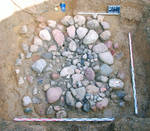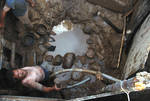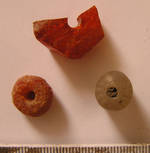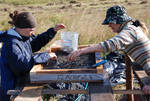Area 2
The well in area 2 has been excavated last year only to a depth of about 1.4 m, overlaid in the centre by the cross-profile necessary for technical reasons of excavation (results 2006 - area 2). This cross profile first of all had to be removed, whereas it was important to follow the same steps as in the last year, in order to fill gaps in the documentation. Simultaneously this offered the possibility of separating the upper filling layers to distinguish different filling phases.
Afterwards the following strategy was used: first of all the northern half of the feature was deepened down for half a meter and the profile was documented. After that the remaining southern half was excavated.
This procedure was retained to a depth of about 3 m under the ground level. In all levels the construction of the well was clearly recognizable (fig. 1).
The biggest problem during the excavation was the high amount of ground water continuously coming out of the ground. It had to be pumped out of the excavation trench (fig. 2). In a depth of about 4 m the walls of the excavation area began to be instable, wherefore the excavations had to be stopped without discovering the expected wooden construction on the bottom. But by discovering charcoal probes in the construction pit, which surrounded the inner lifting hole of the well, it could be dated into the 11th cent. A.D.
In the filling of the well again a huge amount of animal bones and pieces of pottery as well as some further single finds were found. Worth mentioning are two amber beads, a bead of rock (fig. 3), several fragments of loom weights and the fragment of a bone comb. By elutriating (fig. 4) the entire filling of the well the recovery of smallest bones was possible, among them frog and fish bones.
The manner of construction of the well with a quadratic pit, in whose centre a lifting whole built of stones was going down through thick layers of clay into the aquiferous sand could be clarified doubtless. The complex design and the monumentality of the structure lead to the suggestion that the settlement, which has to be expected in the direct vicinity of the feature, was planned as a permanent settling. It is also an expression of a well organised society which could realize such an elaborate common asset.
[top]





